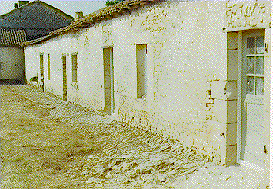course#3 -
Restoration and building of
DRY-WALLS USING FIELD
STONES AND LIME
Two small dry walls also had to be rebuilt above two doors. As the
opening for the oak boards was very narrow it was essential to build tension
releasing arches in these cases.
- The door frame was first prepared and the assembly mounted as described in
courses 1 and 2.
- An old piece of sound oak board which had the right thickness and depth
was cut to the correct length and placed in the opening.
- A collection of slabs with good fit for the arch was put aside.
- The supporting section below the arch was then built up and sealed
with lime. While doing this the fit of the prepared slabs was also
checked
- All of the slabs were then placed without lime trying to get an optimal
fit. The stones are then removed again and sealed with lime working upwards from
both sides at the same time.
- As soon as the arch takes up the forces it tries to break out towards
front or back. It is therefore important to build up a solid
supporting wall in back of it. I did this by using plates to a
large extent.
- The remainder of the wall was then built up to the roof. As the
former owner did not let me use the scaffolding which he never uses anyway,
I had to do this work using a leather and climbing up and down about 200
times per door opening.

- Above pictures also show that the side walks along the buildings were
completely grown over due to neglect by the former owners.
- These side walks all along the buildings are mostly made of vertically
placed stones. This results in a very solid paving but has the
disadvantage that vertically placed stones are far more exposed to freeze
cracking than horizontally placed ones. Water penetrates much
more readily into the exposed layers of the stone grains when the stones are
in upright position.



- The technique used to remove the covering grass has been shown in lesson 1
of course 2.
- Roughly 250 square meters of side walk had been cleaned in 1999.
- This work is best done after the rainy season and I used the very humid
early summer period of the year 2000 to clean the ramp of the pond well.
- Roughly 5 square meters of the ramp is damaged and will need to be repared
as is visible on the right bottom picture.






The many roofs of the old farm buildings will need to be repaired soon as
they have been terribly neglected by the former owners. For this reason I bought
1000 pieces of old tiles from my very nice German neighbor in Epanvilliers.
The whole pile took 7 round trips with my car. I had to collect the tiles on the
first level of the neighbors house and load them in my car. This took
roughly 30 minutes for each load including the 2 minutes trip back to the
castle. I then had to unload the tiles building up the pile shown below,
which took about 15 minutes. To enter and drive back out I had to cross
the main gate as I had blocked my own access in order to protect l, the former
owner, from deft. This very person closed the main gate 14 times
on me - closing all of the locks and padlocks every times in order to give me a
hard time. The twelfth time I caught him at the gate just about to close
the gate again. I got out of the car and yelled at him.

Literature
Der Maureer, A. Opderbeck, Leipzig 1910 (ISBN 3-8262-1504-4)
Techniques
et pratique de la chaux, Eyrolles 1955 (ISBN 2-212-07216-3












